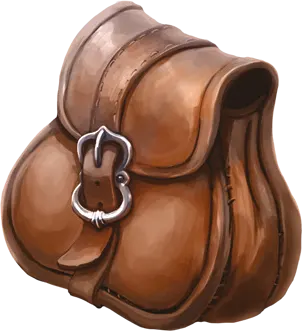
Coin Bag and Coin Pouch
“Thieves hesitate when a burgher carries his ducats in a bag or wears a coin pouch on the belt.”
-old written record found in the Temple of Phex in Gareth
It is no secret that adventures can be highly profitable. Keeping your money in a vault or bank is one thing, but carrying it around is an entirely different matter. Out of necessity, people need secure means to carry their belongings. One solution is the simple coin bag, a circular piece of leather with a strap or lace threaded through holes near the edge. By drawing both ends of the lace tight, the leather folds up and forms a bag that is then tied to a belt. Coin bags can also hold rings or jewels, if needed, but wise burghers know that cutpurses usually steal the entire bag or at least cut a hole in it to steal its contents. Larger bags hold more coins, though at the cost of appearing more obvious.
Unlike its simple relative, the coin pouch has pockets for organizing different types of coins. It consists of three or more tongue-shaped pieces of leather or cloth placed on top each other and sewn together at the edges, creating bag-shaped pockets to hold coins and small trinkets. Coin pouches normally seal with two interlocking copper rings.
Some think coin pouches are sometimes called money cats because they had to be made from cat skins during a leather shortage long ago. Others believe that the term money cat just sounds more civilized. The common saying, “rub the cat,” stems from a merchant habit of encouraging undecided customers to rub the cat, meaning, to see if their coin pouch contains enough coins for the purchase.

“A coin bag is no obstacle for an experienced cutpurse.”
— Carolan Calavanti, Vinsaltan vagabond

“I prefer money cats.”
— Rowena of the Transweal, Bornish cat witch

“I thought you might.”
— Carolan Calavanti, Vinsaltan vagabond
